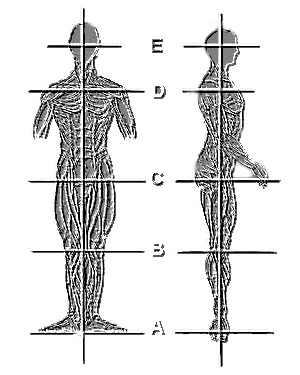|
Classical Dance Development Based Biomechanical Analysis
and Orthopedics 101
Stephen M. Apatow, Founder, Director of Research
and Development, Sports Medicine & Science Institute and International Dancescience Development
Program*
[Vitae][Email]
* Humanitarian Resource Institute,
Humanitarian University Consortium Graduate
Studies Center for Medicine, Veterinary Medicine and Law.
Introduction
Classical ballet training represents
the most advanced technical movement mechanics training in the world.
The mechanical alignment ideal in classical ballet training represents
the most stable, functionally integrate relationship of the spine and
extremities.
An understanding of mechanical ideal
is crucial for optimum control of the human frame in space, strength,
leverage mechanics and economical movement. This foundation established
in conjunction with sports specific movement mechanics is the key to successful
Olympic development programs.
A correct understanding of the classical
ballet mechanical ideal provides the physician, therapist, coach or student
a reference point for alignment deviation as it cooresponds to the mechanism
of joint stress and injury of the spine and extremities.
According to the Merck Manual of Medical
Information for Sports Injuries: "More than 10 million sports injuries
are treated each year in the United States." The seriousness of this
problem points to the need for education initiatives which target injury
prevention.
The Mechanical Ideal
Orthopedics Fundamentals 101 encompasses
a basic understanding of classical ballet based postural alignment.

|
In order to develop precision control
of the human frame and center of gravity, the body must be correctly
aligned and connected as one unit (bottom of the feet to the top of the
head).
To do this, the weight must be placed over the center of the feet
(A), with even distribution, connected to facilitate progression to demi-pointe
and pointe.
Incorrect weightbearing on the foot/ankle complex corresponds
with numerous injuries including ankle sprains, achilles tendonitis and
bone growth patterns (bunions) to accomodate abnormal stresses.
As the legs are bent, the knee caps (center of patella) should track
directly over the center of the ankle and foot (A,B).
If a plumbline drops to the inside of the foot complex, internal rotation
of the knee joint is the cause of many developmental challenges that include
the most common mechanisms of knee injury (internal rotation) and torsional
stresses of the ankle/foot complex .
|
Hip rotation (C) is the determining factor for the functional turnout,
based on correct alignment of the knee, ankle and foot complex. Working
outside of the range of motion in the hip complex contributes
to significant compensatory torsional shifts in the pelvis and spine which
contributes to the mechanism of numerous neurological and lower extremity
problems.
The upper and lower extremities are connected by the abdominal and
erector muscles of the lower back. Lack of abdominal strength and
connection of the erector muscles (controlled lordosis) combined with disconnected alignment of the
upper extremity contributes to significant stresses in the spine.
The shoulder complex (D) is held back and down with concurrent contracture
of the pectoral (chest) and latissimus (upper back) muscles (base of occiput
over the head of the humerous that slightly behind the clavicular head).
If the shoulder complex is positioned forward
(hunched shoulders), cervical/thoracic integrity is comprimised and contributes
to cervical spine injuries, anterior shoulder injuries
(long head of the bicepts tendon) and compensatory shifts of the extremity
(arm, wrist and hand complex: contributing to syndromes referred to as
tennis elbow, carpal tunnel syndrome, etc.).
The correct alignment of the head and neck (E) is achieved when the
base of the skull is aligned over the shoulder complex with contracture
of the sterncleidomastoid muscles in the front of the neck.
Anterior alignment of the head and hyper lordosis of
the cervical spine has been found to contribute to the mechanism of joint
stress and in extreme cases discal herniations.
A new international standard
for classical ballet development
In an effort to optimize performance and maximize injury prevention, a
new international standard is being established that focuses on integration
of a classical ballet specific stretch series, for a minimum of 30 minutes before
every classical ballet technique class:
Selected Bibliography
Agrippina Vaganova, Basic Principles
of Classical Ballet, Dover, 1969
Alfred A Knopf, The Classic Ballet, New York, 1984
Clinics In Sports Medicine, Injuries to Dancers ,Saunders 1983
Beryl Dunn, Dance! Therapy for Dancers, London, 1994
Donald F.Featherstone, Dancing Without Danger, 1970
L.M. Vincent, The Dancers Book of Health, Andrews and McMeel,
1978
White-Panjabi, Clinical Biomechanics of the Spine, J.B. Lippincott,
1978
Rosse-Clawson, The Musculo-Skeletal System in Health and Disease,
Harper & Row, 1970
Stanley Hoppenfeld, Physical Examination of the Spine and Extremities,
Appleton, 1976
|